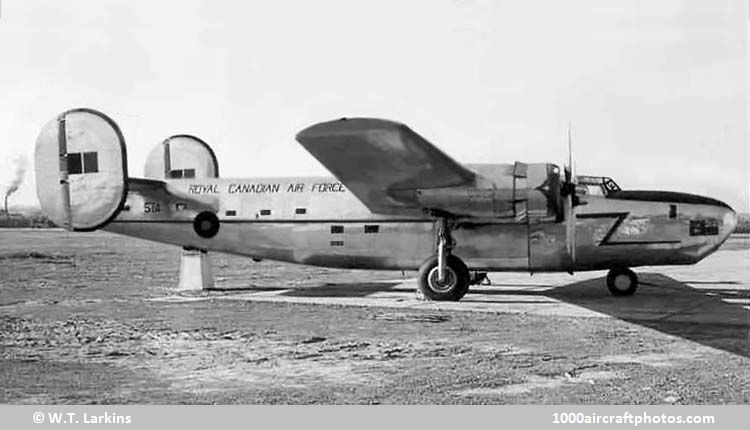04/30/2015. Remarks by Johan Visschedijk: "Built as a B-24J-65-CF under the USAAF serial 44-10583 by Consolidated at Fort Worth, Texas, this aircraft was transferred to the RCAF as a Liberator GR.Mk.VI (s/n 574), on July 30, 1944. Along five more Liberators it was delivered direct to No. 4 Repair Depot at Scoudouc, New Brunswick, for conversion to a transport and this aircraft was fitted with a VIP interior, including twelve seats, a galley and a toilet as well as an extra side door and a highly polished exterior.
Unofficially designated GR.Mk.VIT and coded "QJ", it began operations with No. 168 (Heavy Transport) Squadron, RCAF Station Rockcliffe, Ontario from August 30, 1944 till early 1946. It flew the Canadian Prime Minister Mackenzie King and his staff to the first UN meeting in San Francisco, California, USA in June 1945. On July 15, 1946, the aircraft was transferred to No. 12 (Transport) Squadron and carried more VIPs, including the Governor General and family. In 1947-1948 it was with No. 412 (Transport) Squadron, RCAF Station Rockcliffe, Ontario, and flew General H.D.G. Crerar on a tour of the far east in the summer of 1947, visited Hawaii, Johnston Island, Kwajalein, Tokyo, and Nanking. The aircraft was stored at Trenton, Ontario in 1948 and struck off charge on June 8, 1948 and put up for sale by the War Assets Corporation.
In 1948 it was sold to E.J. Rohrt, one of the partners of the aircraft brokerage company Eivind Rohrt Aviation Supply Co. at Dallas, Texas, USA, and on a limited permit (NL1246V) it was registered as a C-87 (the designated 25-seat transport version of the B-24). By 1951 the had been sold to another Dallas brooker, McGhee-Ingram Inc., who had had freight doors installed in the left-rear fuselage, while the twelve-seat interior remained unchanged.
The aircraft was purchased by Air Chile Ltda. through the Chilean Nitrate Co. and was registered in Chili as CC-CAN on December 12, 1951, soon thereafter it was named Ciudad de Iquique (City of Iquique). On September 30, 1952, after a total of 1,300 flying hours, the aircraft had a mishap at Aeropuerto Cerro Moreno near Antofagasta. Shortly after initiating the take off run for a flight to Iquique, the nose wheel retracted and the nose hit the runway; there were no injuries amongst the three crew and two passengers. Despite the minor damage to the nose and engine cowlings it took till late December 1953 before the aircraft returned to service.
The end of a flight from Iquique to Santiago on February 21, 1955, was also the end of CC-CAN, after only 2,371 hours total flying time. A hard landing at Aeródromo Los Cerrillos in Santiago caused the right landing gear to collapse and the aircraft skidded off the runway. The landing gear was damaged, as was the right wing and flaps, engine and propeller, while the fuselage showed some cracks. None of the three crew and fifteen passengers (three more than allowed!) sustained injuries. Although the aircraft was repairable, due to lack of expertise and the financial state of the airline the aircraft was abandoned at the airport and scrapped in late 1959, the registration was cancelled on March 7, 1961."
